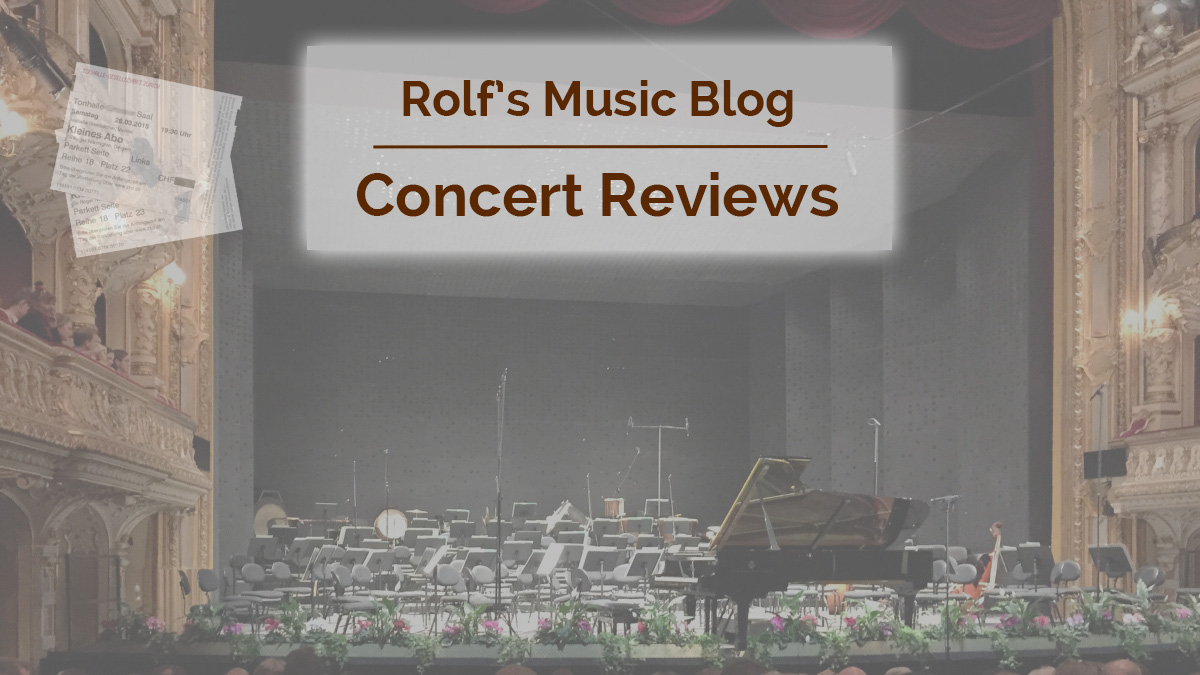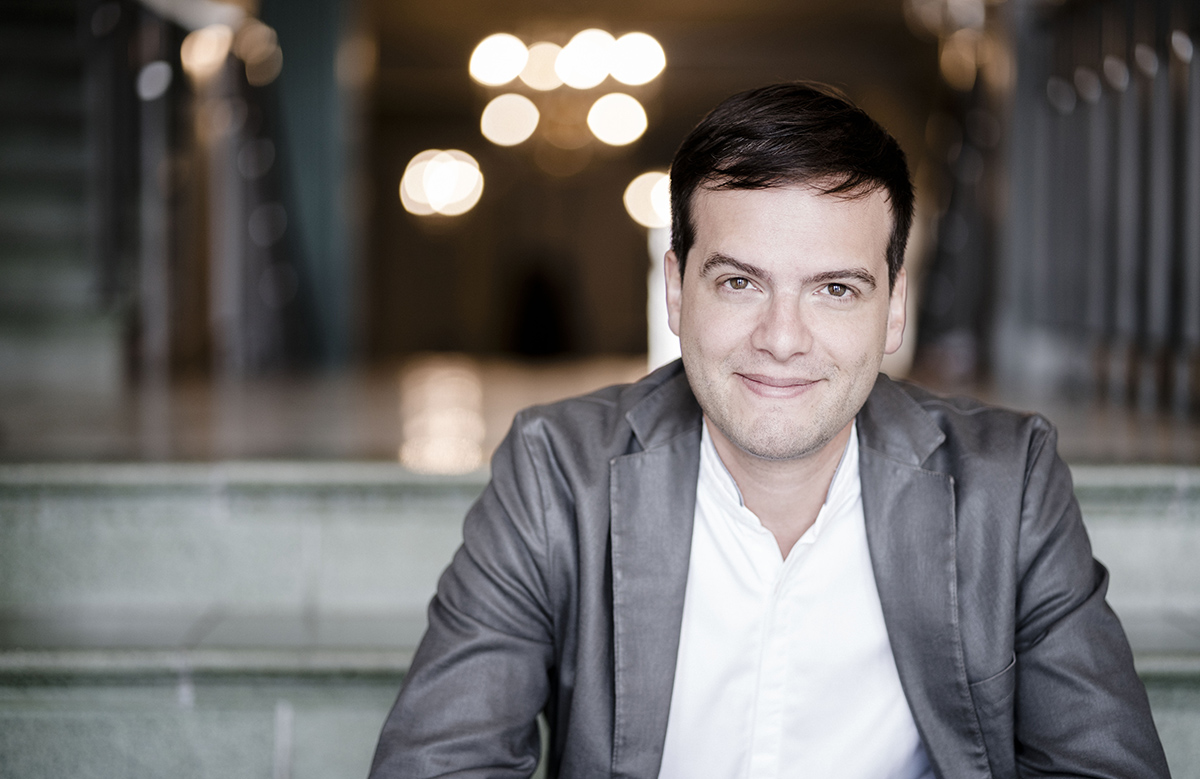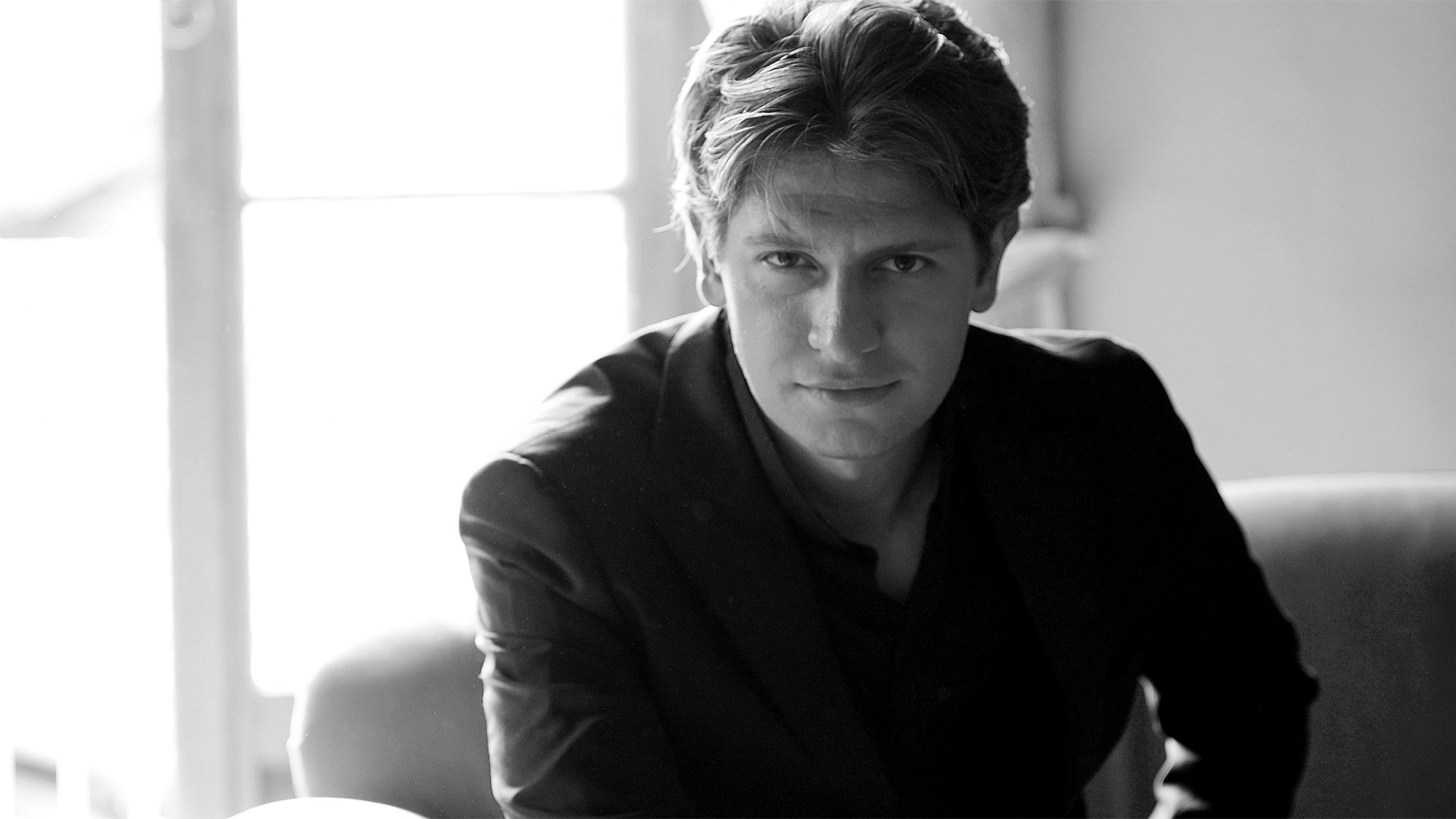Francesco Piemontesi, Daniele Rustioni / Philharmonia Zürich
Mozart / Strauss / Shostakovich
Opera Zurich, 2018-10-28

2018-11-12 — Original posting
Piemontesi ergänzte Mozart und erzählte Geschichten in Strauss’ Burleske — Zusammenfassung
Francesco Piemontesis Interpretation von Mozarts Rondo K386 war gelungen—so gut es eben möglich ist auf einem modernen Konzertflügel. Es fehlte etwas an der Raffinesse, der ganz leichten Artikulation, am Farbreichtum, die auf historischen oder rekonstruierten Fortepianos aus dem späten 18.Jh. möglich sind. Der Pianist ergänzte die von Mozart nicht fertiggestellte Partitur mit zusätzlichen Variationen, Verzierungen und mit einer eigenen Kadenz, die gut zum Rondo passte, auch wenn sie nicht ganz im Stile Mozarts war.
Obwohl der Klavierpart in Strauss’ Burleske TrV 145 hoch virtuos ist, schien der Pianist keinerlei technische Schwierigkeiten damit zu haben. Im Gegenteil, mit viel Schwung stürzte er sich in die fallenden Akkordkaskaden zu Beginn. Nichtsdestotrotz blieb sein Anschlag “human”, gelegentlich gar weich, sanft in den lyrischen Passagen. Generell strich er nicht den burlesken Aspekt, die Parodie, die Ironie heraus. Vielmehr erzählte er Geschichten, fokussierte auf singende Kantilenen in Strauss’ typisch melancholischem Ton.
Der am meisten burleske Part fand sich direkt vor der eruptiven Partie der quasi-Kadenz. Letzter, sowie die sehr kräftezehrende Coda waren brillant, technisch makellos, sehr eindrücklich.
Daniele Rustioni und das Orchester folgten dem Solopart perfekt durch alle Rubati und agogischen Finessen—eine exzellente Begleitung.
In Schostakowitschs Sinfonie Nr.5, op.47 bestätigte die Philharmonia Zürich unter Daniele Rustioni ihren ausgezeichneten Ruf. Im ersten Satz klangen die Streicher zu Beginn leicht spröde, und zum Schluss hin ließ die Spannung etwas nach. Jedoch gab es auch eindrückliche Momente, auch in den Folgesätzen. Das Orchester zeigte seine Qualitäten in Koordination, Klarheit, Transparenz und Klangfülle.
Table of Contents
- Introduction / Artists
- Concert & Review
- Mozart: Rondo for Piano & Orchestra in A major, K.386
- Strauss: Burleske for Piano and Orchestra in D minor, TrV 145
- Encore 1 — Mozart: Sonata in D major for Piano 4 Hands, K.381
- Encore 2 — Handel: Minuet in G minor, HWV 434-4
- Shostakovich: Symphony No.5 in D minor, op.47
- Conclusion
Introduction / Artists
This was the first of the Philharmonic Concerts of the season 2018/19 at the Zurich Opera House. In the center of the concert was—naturally—the in-house orchestra, the Philharmonia Zurich. However, this time, the orchestra worked with the Italian guest conductor Daniele Rustioni (*1983, see also Wikipedia). Rustioni not only studied conducting, but also piano (more on that below!), organ, and composition. During his studies at the Royal Academy of Music in London, his mentor was Gianandrea Noseda (*1964). For 3 years, he was assistant to Sir Antonio Pappano (*1959) at the Royal Opera House in Covent Garden. 2014, he became principal conductor of the Orchestra della Toscana. In addition, 2015, the Opéra national de Lyon appointed Rustioni its principal conductor, starting 2017.
The first half of the concert featured a soloist at the piano: the Swiss pianist Francesco Piemontesi (*1983). I have previously reviewed a concert with this artist, in Zurich, on 2017-10-18. See my earlier posting for additional information on Piemontesi.
Program
- Mozart: Rondo for Piano & Orchestra in A major, K.386
- Strauss: Burleske for Piano and Orchestra in D minor, TrV 145
- Encore 1 — Mozart: Sonata in D major for Piano 4 Hands, K.381
- Encore 2 — Handel: Minuet in G minor, HWV 434-4
(Intermission)
- Shostakovich: Symphony No.5 in D minor, op.47
Venue, etc.
I have written about a fair number of Philharmonic Concerts in this venue, so I don’t need to discuss this here. There was one difference, though. I did not attend the concert as official reviewer, and so, my wife and I wanted to take this as a chance to try out seats in on the first balcony. We had seats on the left, in row 4. These offer fairly good view onto the stage.
However, the soloist and major parts of the orchestra were performing above the orchestra pit, and that part of the venue (the entire parquet of the hall) is hidden to visitors in rows 3 and higher. In this concert, this was OK, as I could step out from seat #1 in my row, to get a glimpse of soloist and conductor performing. The acoustics are OK anyway, throughout the venue. Next time, we’ll try lateral seats on the second balcony, though, for better viewing conditions.
The venue was essentially full for this concert, the empty seats almost certainly were from subscribers who did not show up.
Concert & Review
Mozart: Rondo for Piano & Orchestra in A major, K.386
Musicologists think that the Rondo for Piano & Orchestra in A major, K.386 by Wolfgang Amadeus Mozart (1756 – 1791) is a composition from late 1782. Mozart did not publish the movement, though. His widow sold the manuscript in 1799. Already then, some pages were missing. Worse than that, the remaining pages were auctioned off. Not as a whole, not as sheets, but with some sheets even cut in half. For a long time, only fragments were known, and people thought that the composer did not complete the movement. Through lucky circumstances, though, major parts of the manuscript have since been located. With the help of a piano transcription from 1838, the movement could largely be reconstructed. The score available now should be quite close to Mozart’s original.
In a separate post, I have done a short comparison of several recordings of this composition. See there for more detail.
The Performance
For Mozart’s Rondo in A major, Rustioni worked with a suitable, smaller orchestra formation (about 30 string players), in a “romantic” setup (both violin voices on the left, violas and double basses on the right). The piano (expectedly) was a modern concert grand (Steinway D-274).
Rustioni selected a natural tempo, well in the range of Allegretto: swift, but not rushed, nor overly relaxed. Light articulation, careful, differentiated dynamics, and the wind instruments (2 horns, 2 oboes) blended nicely with the string sound.
In his interpretation (dynamics, phrasing), Francesco Piemontesi was in full harmony with the orchestra. He articulated very carefully, paying attention to details in the notation. This does not imply that he felt like the slave of the notation. The score is a reconstruction, the movement not published and probably never “fully completed”. Therefore, some freedom in (extra) ornaments and articulation is certainly OK / acceptable. More than that: the Rondo has a certain “ear-worm potential”. So, extra variations and ornaments (especially in recurring segments) are even desirable.
Variations
I certainly found such “deviations” attractive, interesting. One example: in bar 56, the pianist took the liberty to change each of the four semiquaver triplets into semiquaver + two demisemiquavers (inégal playing). And that was just the beginning: throughout the movement, he freely added occasional ornaments (“mini-cadenzas”), varied the rhythm in motifs, etc. He did this with phantasy and imagination, and perfectly fitting. A listener who didn’t know the work could barely recognize these “extras”. Sure, somebody who heard the “plain” version once would easily spot them. However, not as stumbling blocks, but rather with pleasure, maybe a smile. And with admiration for their fluent, rolling naturalness.
Towards the end of the movement, the proportion of reconstructed notes increases, and one could certainly sense this also from the amount of freedom that Piemontesi applied to the text. I liked the cadenza (close to the ending). Yes, it clearly wasn’t Mozart’s, had more experimental character. But still, it suited the work very well.
Overall: an excellent performance, about as good as it can get on a modern concert grand. I mean: I did miss a bit the refinement, the extra colors, and the lightness in articulation that one can only achieve on a historic instrument. Or, probably better, on a good replica of a fortepiano from the late 18th century.
Rating: ★★★★
Strauss: Burleske for Piano and Orchestra in D minor, TrV 145
Earlier this year, I have attended a concert featuring Strauss’ Burleske, in Zurich, on 2018-01-25. Let me take a shortcut by just quoting from that earlier post, where there is also additional information:
Richard Strauss (1864 – 1949) wrote a first version of the Burleske (farce, mockery) as Scherzo in D minor for piano and orchestra in 1885 – 1886, at age 21. He wrote it for Hans von Bülow (1830 – 1894), who rejected it as unplayable and “nonsense”. So, in 1889, he revised the work, now called Burleske, and dedicated it to the pianist and composer Eugen d’Albert (1864 – 1932). The piece premiered with d’Albert, with von Bülow conducting. However, the latter still commented “Strauss’s Burleske decidedly has some genius in it, but in other respects it is horrifying”. Only in 1894, Strauss agreed to publishing it, himself not convinced of its qualities. It later became one of his favorite pieces, though.
The Performance
Francesco Piemontesi was certainly not trying to hold back the flow in his first solos. He picked up the momentum from the short orchestral introduction, almost seemed to lean forward in the descending chord cascades. The solo part is highly virtuosic. However, the pianist did not appear to have any technical issues with it.
Lyrical Moments
I felt that in his keyboard touch, Piemontesi avoided “steely”, razor-sharp articulation. Rather, his touch remained “human”, even relatively soft, gentle, especially in the lyrical passages (e.g.,, in the solo starting at [C]). In the first part, he didn’t so much expose the burlesque aspect, the parody / irony. Rather, Piemontesi seemed to focus in on the singing, telling stories, with Strauss’ typical, slightly melancholic tone. Those beautiful cantilenas, so typical of Strauss!
Rhapsodic
But, of course, in the pomposo solo, he turned out the rhapsodic mode, the grandiose gestures. In earnest, or irony? Similarly, was the grazioso in the following solo ironic? Or maybe purposefully ambiguous?
Initially, the piano stayed in the center of the attention. The big, expressive tutti (from around [O]), at last, did justice to the orchestra. However, when the solo returned, it again kept Francesco Piemontesi busy. Still, the soloist maintained contact with orchestra and conductor. The lyrical parts returned, and with these, the warm expression in Piemontesi’s playing. And there is another rhapsodic part (after [Cc]), in which the soloist could play out the big gestures—and expose his technical mastership.
Burlesque?
The “most burlesque part” seemed the section prior to the eruptions of the quasi cadenza, where the tranquillo in the solo is repeatedly interrupted by violent feroce interjections from the orchestra: this felt like a premonition of Till Eulenspiegel’s Merry Pranks, op.28 (1895). The (quasi) cadenza itself, and the strenuous coda was brilliant, technically flawless, impressive.
Rustioni and the orchestra closely followed the soloist through all rubato and agogics: excellent accompaniment. Strangely, the timpani were noticeably out-of-tune. This felt fairly odd for what might sometimes sound like a concerto for piano, timpani and orchestra.
Rating: ★★★★
Encore 1 — Mozart: Sonata in D major for Piano 4 Hands, K.381
For the first encore, Daniele Rustioni unexpectedly sat down at the piano, playing the secondo part next to Francesco Piemontesi. The latter announced the final (third) movement, Allegro molto, from the Sonata in D major for Piano 4 Hands, K.381 / 123a, a composition from 1772, by Wolfgang Amadeus Mozart (1756 – 1791), a joyful, almost boisterous piece. For the two artists, the focus seemed to lie on lively expression, on drive & momentum, more than on detailed & careful performance. I think they both deserved having some fun after Strauss’ Burleske! It wasn’t exactly a last dance prior to the intermission, though:
Encore 2 — Handel: Minuet in G minor, HWV 434-4
There was no need to apologize for the excessive fun in the Mozart sonata movement! Still, as if he wanted to compensate that, Francesco Piemontesi offered a second (and last) encore: the Minuet in G minor, HWV 434-4 by George Frideric Handel (1685 – 1759). People erroneously took this Minuet as fourth movement of the Keyboard Suite in B♭ major, HWV 434. Musicologists since found out that it is not related to that suite (*). It is calm, reflective music, introverted and poetic. Piemontesi did the repeats with playful, fitting ornamentation. Beautifully playing, for sure—even though more contrast than fitting complement to the Mozart movement.
*) The third movement of that suite served as theme for the Variations and Fugue on a Theme by Handel, op.24 by Johannes Brahms (1833 – 1897). Handel re-used the Minuet as fourth movement in the Flute Sonata in E minor, HWV 375.
Shostakovich: Symphony No.5 in D minor, op.47
Dmitri Shostakovich (1906 – 1975) wrote his Symphony No.5 in D minor, op.47 in 1937. The work premiered in November of the same year in Leningrad (St.Petersburg) by the Leningrad Philharmonic Orchestra under Yevgeny Mravinsky (1903 – 1988). The Symphony was an instant, huge success. There are four movements:
- Moderato (1/8=76) — Allegro non troppo (♩=126)
- Allegretto (♩=138)
- Largo (♩=50)
- Allegro non troppo (♩=88) — Più mosso (1/2=72) — Poco animato
For a detailed description and a detailed discussion of the work, its reception / performance history, and its movements see Wikipedia.
The Performance
Here now, the orchestra filled the podium / the stage for the rich instrumentation in Shostakovich’s symphony: piccolo, 2 flutes, 2 oboes, piccolo clarinet, 2 clarinets, 2 bassoons, contrabassoon, 4 horns, 3 trumpets, 3 trombones, tuba, timpani, triangle, snare drum, cymbals, big drum, tam-tam, Glockenspiel, xylophone, celesta, 2 harps, piano, strings.
I. Moderato — Allegro non troppo
Daniele Rustioni’s resolute conducting matched the character of the Moderato beginning, with its double punctuations. After the introductory “statement”, though, the music retracts into a subtle p, starting to build expectation & tension. In this soft build-up, the strings sounded unusually thin, somewhat brittle (violins).
The coordination was just fine, yet the sound felt strangely incoherent. It seemed to take quite a while and some ff passages for the strings to re-gain coherence and firmness. There were some stunning moments in the performance. One example was the amazing morendo into ppp and beyond in the clarinet, a few bars before the piano sets in. Also later in the movement, the performance of both the flute and clarinet solos were breathtakingly clean and smooth.
In general / for most of the movement, the tension was OK (especially in the accelerando and the first part of the Allegro non troppo). However, there were also periods when the music lacked a compelling pull forward. And I missed the menacing undertone that is so typical in much of the music by this composer. In a way, it felt as if Rustioni concentrated on the performance (coordination, dynamics, etc.), but wasn’t quite able to convey the underlying (political?) content. Consequently, there were moments towards the end of the movement I noted a gradual loss in tension.
★★★
II. Allegretto
Initially, the dissecting, analytical / dry theater acoustics seemed to defeat the coherence of cellos and double basses. But these were just initial issues. Soon, Daniele Rustioni appeared to feel more “at home” in this movement: jolly, joyful music, with laughing episodes. It is quite demanding in terms of coordination. The orchestra was excellent. It showed its qualities in coordination, clarity and transparency.
★★★½
III. Largo
The beginning of the Largo feels like a fugato in its polyphony. All retained for a long period, serene, calm—and forlornness, loneliness. Very nicely shaped in its dynamics, with careful dynamics, excellent sonority in its broad build-up waves. Maybe sometimes, a decrescendo was retracting a little fast. However, the sonority remained excellent, even when the second violins seemed to disappear into pppp and beyond. Especially the softest segments showed the true quality of the orchestra.
Also the build-ups to very intense fortissimo (with or without tremolo) retained excellent sonority, and again, the wind soloists (oboe, clarinet) were outstanding. One quibble I have, though: in the soft segments, the conductors (excessive) conducting gestures visually seemed to disrupt the calm.
★★★½
IV. Allegro non troppo — Più mosso — Poco animato
Here, Rustioni started accelerating already in the first 7 bars, before the composer annotated accelerando poco a poco. Consequently, the tempo soon seemed to reach, if not exceed the limit, where the coordination started to suffer, and fast figures began to sound blurred. The orchestra is not to blame: its playing was active and engaged throughout.
The coordination was better where the strong timpani beats marked the pace. Still there seemed to be too much pushing, an occasional excess in restlessness. Yes, the music is beautiful, marvelous, impressive. And yet, I felt that Rustioni didn’t entirely succeed in conveying his intentions through the orchestra.
Prior to the last build-up, the music appears to dissolve into serenity, calm, an idyl, sunshine. Though—of course—that’s not the ending: the tension is growing again, the snare drum softly indicates an imminent threat, as the volume gradually builds up towards the final climax. And here, the strings now are entirely firm, intense, coherent: a compelling ending in excellent sonority!
★★★
Overall Rating: ★★★½
Conclusion
My comments above may sound critical. However, one should bear in mind that a performance with a guest conductor is (almost) always a challenge, for both the orchestra and the guest. A five-star concert experience in such a situation is a rare exception, if not an extraordinary coincidence.



